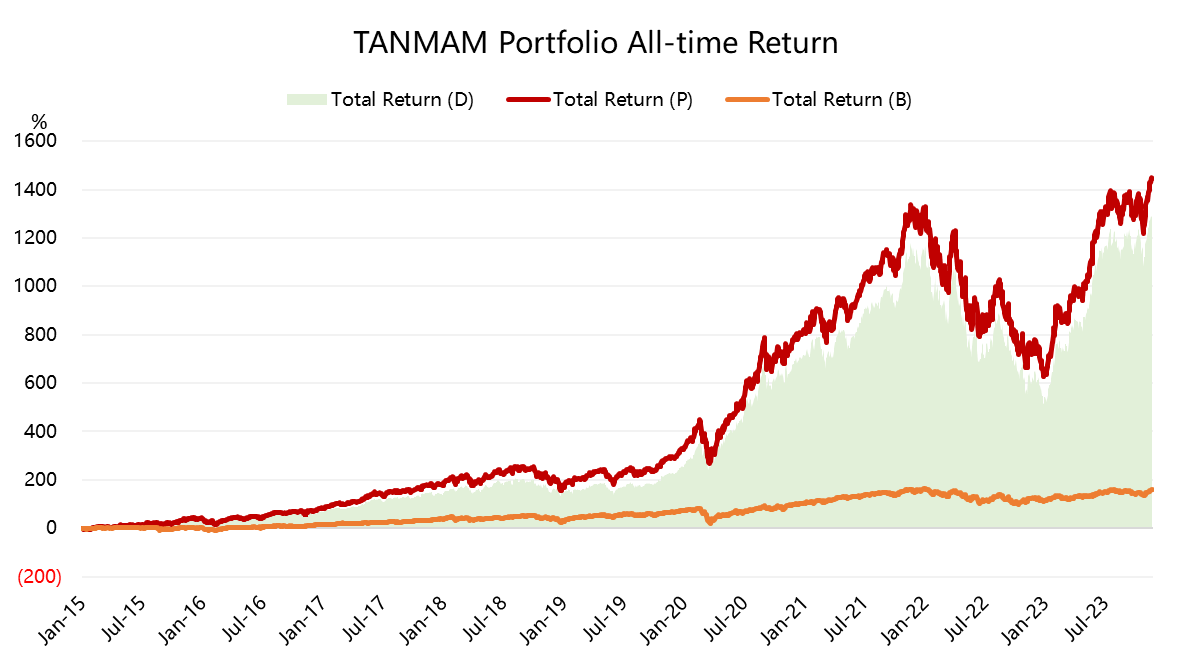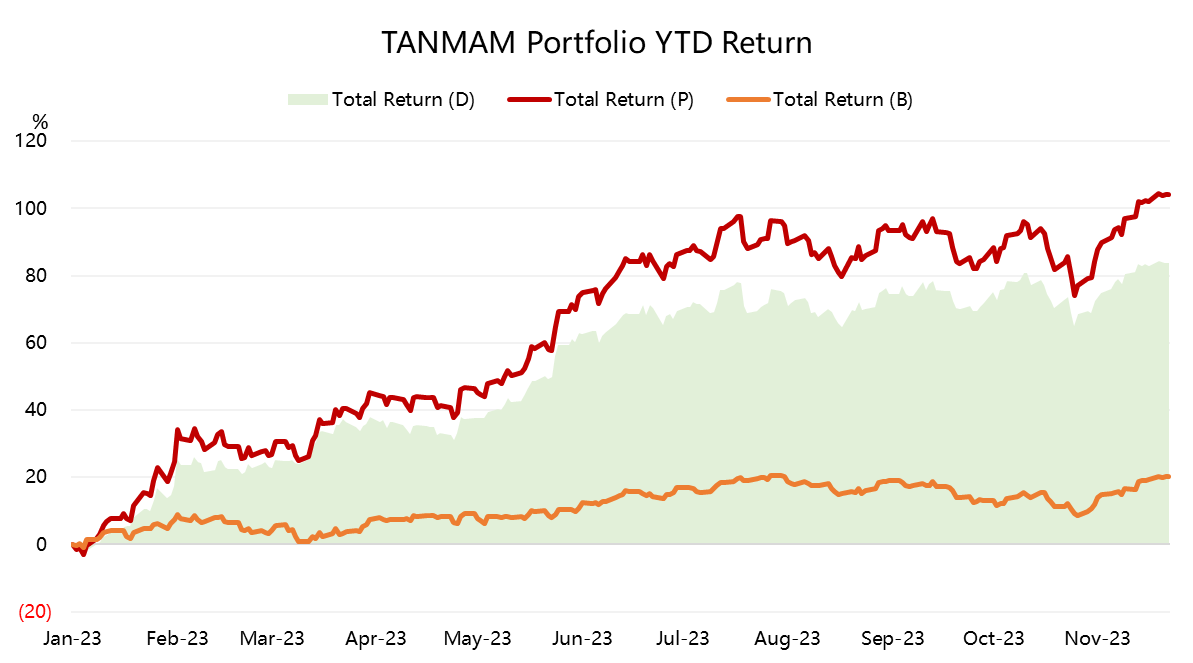BIG TECH WEEKLY | Why could it beat all Magnificant Seven?
Big-Tech’s Performance
Before Thanksgiving, the market continued to rally. Despite the impressive financial performance of AI leader NVIDIA, it was unable to lift the technology stocks to a new platform, resulting in a narrowing of the market's gains and a trend of high altitude chilliness.
Big tech continued to lead the way, with the $NASDAQ 100(NDX)$ hitting new highs.
As of the close on November 16th, the best-performing stocks in the past week (only 4 trading days) were $Alphabet(GOOGL)$ with a gain of 2.87%, followed by $Meta Platforms, Inc.(META)$ ith 2.64%; $Amazon.com(AMZN)$ with 2.45%; $Microsoft(MSFT)$ with 2.21%; $Apple(AAPL)$ with 1.76%; $NVIDIA Corp(NVDA)$ with a decline of 0.35%, and $Tesla Motors(TSLA)$ with a pullback of 3.55%.
Big-Tech’s Top Newsfeed
The release date of Apple's VR headset Vision Pro may be delayed until March next year.
Apple CEO Tim Cook hopes the next CEO will come from within Apple.
Analyst Ming-Chi Kuo predicts a surge in shipments of Apple and Huawei smartphones with periscope lenses next year.
Apple will pause advertising on social media platform X (Twitter).
According to third-party data, Xiaomi and Huawei saw double-digit increases in smartphone sales during the Singles' Day period, while Apple saw a 4% decline.
OpenAI founder drama continues as Sam Altman returns temporarily, and Microsoft may join the OpenAI board of directors.
Jeff Bezos has recently sold a significant amount of his Amazon shares.
NVIDIA's Q3 data center revenue exceeded expectations.
NVIDIA has significantly increased chip supply and expects the new chips to not contribute to revenue in the current quarter.
The launch of NVIDIA's redesigned AI chip H20 for the Chinese market may be delayed until mid-next month.
An insider from Tesla China confirmed that progress is being made regarding the implementation of FSD (Full Self-Driving) in China.
Big-Tech’s Key insights
Why is NVIDIA struggling despite strong performance?
NVIDIA's Q3 financial report, released on November 21st, exceeded expectations once again, with the data center segment (representing AI computing power) surpassing already raised guidance, indicating strong demand in the AI sector. However, NVIDIA's stock price declined instead of rising (although it had followed the market's upward trend before the financial report).
According to Ming-Chi Kuo, the performance expectations of sellers and buyers are inherently different, with sellers having lower expectations and buyers having higher demands. Therefore, the buyers who determine the price did not find this performance "too surprising," and thus did not significantly increase their positions.
Another explanation is that the market has become desensitized to Q3 and even Q4 earnings exceeding expectations and is now more concerned about the market capacity when it reaches its maximum growth rate in 2024 and 2025. The difference between $50 billion and $100 billion in 2024 is quite significant. Investors will not act rashly without a clear target.
Therefore, the fluctuations around the $500 mark indicate the dilemma faced by investors.
Before Nvidia's financial report, the implied volatility of its options showed that the market expected a volatility of about 10 points, that is, an increase of 10 points, which would forcibly pull the stock price away from the current platform and also promote the broader market to move higher (even to new highs). However, there is almost no volatility now, and instead there is a long and short battle (buyers).
Last week, we also mentioned in the preview of NVDAQ3's financial report that "up and down fluctuations may not be friendly to option buyers" and "shorting volatility has a higher win rate." And the biggest winner of this earnings season is still the option strategy of shorting volatility, such as the butterfly and calendar around $490, which have made considerable profits. And the differential strategy (sellers) with out-of-money also made steady profits.
For investors with limited funds or unwilling to occupy a large weight, Nvidia's currently high price may make the vertical spread strategy with a relatively low margin ratio a good choice. "
Why is it beating all Magnificant Seven?
With Nvidia's financial report released, the Q3 earnings reports of the seven giants have been revealed. In horizontal comparison,
META and AMZN performed relatively well due to industry expectations of a rebound; MSFT was considered "most likely to benefit" by investors due to OpenAI's internal drama and also performed well; GOOGL almost made up for its decline after the financial report; AAPL once again hit $3 trillion, but the gap with MSFT is narrowing; TSLA also did not have much downward momentum in the short term due to expectations for Cybertruck.
However, their performance is not as good as $Netflix(NFLX)$ which released its financial report first.
First of all, NFLX's performance on the day of its financial report was very good, with a beautiful performance reversal and many surprises that exceeded both buyers' and sellers' expectations. The crackdown on password sharing went particularly smoothly, while activating more hidden subscription users also promoted advertising business, with obvious synergies and stable profitability.
In addition, AI applications can improve its advertising efficiency, and even the recently popular short dramas can achieve face-swapping operations. The massive content library of Netflix can be "secondarily processed" and "advertising implanted," with huge incremental space.
At the same time, due to the impact of screenwriter strikes, Disney's Marvel series movies are not well accepted, which also lowers expectations for its 2024 content products among audiences.
The Big-Tech Portfolio
We synthesized these seven companies with the largest weights into an investment portfolio called the "TANMAM" portfolio.
By backtesting this portfolio using equal weights and quarterly readjustment of weights since 2015, the performance has far exceeded the S&P 500, with a total return of 1445%, once again reaching a historic high. During the same period, the S&P 500 ETF (SPY) had a return of 159%, still not reaching a new historical high.
The year-to-date return of the portfolio is 104.15%, higher than the 20.31% of SPY. The Sharpe ratio is 4.6, while SPY is 1.3 during the same period.
The return of the portfolio this week is 0.6%, while SPY's return is 1.06%.
Disclaimer: Investing carries risk. This is not financial advice. The above content should not be regarded as an offer, recommendation, or solicitation on acquiring or disposing of any financial products, any associated discussions, comments, or posts by author or other users should not be considered as such either. It is solely for general information purpose only, which does not consider your own investment objectives, financial situations or needs. TTM assumes no responsibility or warranty for the accuracy and completeness of the information, investors should do their own research and may seek professional advice before investing.




Great ariticle, would you like to share it?